Defining Nature
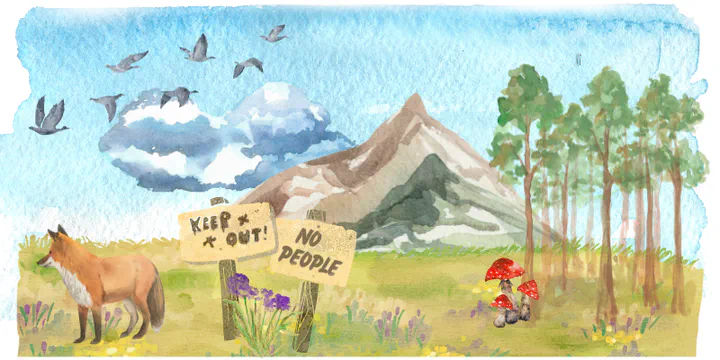
Background
Qualitative Analysis on how people define nature
In every study I have been running for the past 3 years, I’ve included the open-ended question: “How do you define nature?”.
To date, I have 1697 unique defintions of nature, collected from Fall 2022 - Winter 2024 (both student samples on SONA and general public samples on Prolific).
So far, the coding team has only manually coded 766 of these definitions. This document reports what we have found through this manual coding, as well as some of the natural language processing I have done using the R package Quanteda.
Coding Process
Coding was approached from a data-driven perspective. The first step was to look through a sample of 50 definitions and generate descriptive codes to sort them into categories. The coding team had several meetings where we discussed the individually generated codes and agreed upon a code-book to continue coding. This initial coding was completed using a student sample of 103 definitions.
The sample of codes discussed in this post is from Fall 2022 using a Prolific sample. Because the demographics of the sample changed, the codebook was adapted to accommodate the types of themes arising with this population.
The coding team consists of 4-6 coders who individually assign codes to each definition. The team meet weekly to discuss the codes and form consensus on what each definition should ultimately be coded with. If consensus could not be reached, the item was coded based on majority vote.
Code book
The current iteration of the codebook (V2.4) includes the following codes. The full codebook can be viewed here{:target=“_blank”}
Code | Definiton | Example |
|---|---|---|
Naturally occurring/Natural | Specifically says naturally occuring or something that comes with the Earth | “Any element that naturally exists in the world” |
The world around us | Definition describes where people live or what surrounds them. | “Nature is the raw environment that surrounds our civilization.” |
Environment | The word “environment” is present in their definition | “A cultivating environment.” |
Everything | Definition refers to everything in this world. | “I define nature as absolutely everything in the universe; one whole system.” |
Wild | Provides the terms “wild”, “wilderness”, “wildlife” | “It is where wildlife can roam freely and everything is natural.” |
Examples (non-human) | Gives examples (at least one) of “nature” that are for geography, non-living and living things | “The outdoors with trees, the ocean, bugs and animals” |
Not touched by humans | Definition describes nature as not touched, not altered, not made/created by humans, existing without human interference, independent from humanity/human nature | “I would define nature as something that has not been modified by humans.” |
Excludes humans | Outright says that humans are not part of nature. | “the phenomena of the physical world collectively, including plants, animals, the landscape, and other features and products of the earth, as opposed to humans or human creations” |
Includes humans | Specifically includes humans in their definition. You shouldn’t have to struggle to fill their logic. They need to clearly include humans as part of nature. | “Nature includes all humans, animals, plants, and even things like viruses and bacteria.” |
Human-made | This code is for definitions that cite examples of human-made things. Eg. Urban, built, pollution, houses, etc | “Aspects of people’s built environment (e.g., roads, trees, pollution) that can affect overall physical and mental health” |
Metaphyscial definitions | Using non-physical terms to describe nature. Things that cannot be measured | “mother earths beauty” |
Alive | Definition contains the word “alive” | “Anything that comes into being through a biological occurence” |
Outdoors/Outside | Mentions nature being “outside”, “outdoors”, or “out there”. | “The outdoors, things that are not man-made” |
Evaluative | Placing a value on nature that is moral (being good or clean etc), emotional (pleasant, calm), or aesthetic (beautiful), or meaningful in basis (“nice”) | “Beauty, outdoors, clean” |
Descriptive Data
Data collected on 8 Nov 2022
- Sample size = 766
- Mean age: 32.29 years old (SD = 9.9); range: 18, 79
- 391 Females; 366 Males; 9 did not report
Looking at the frequency of codes
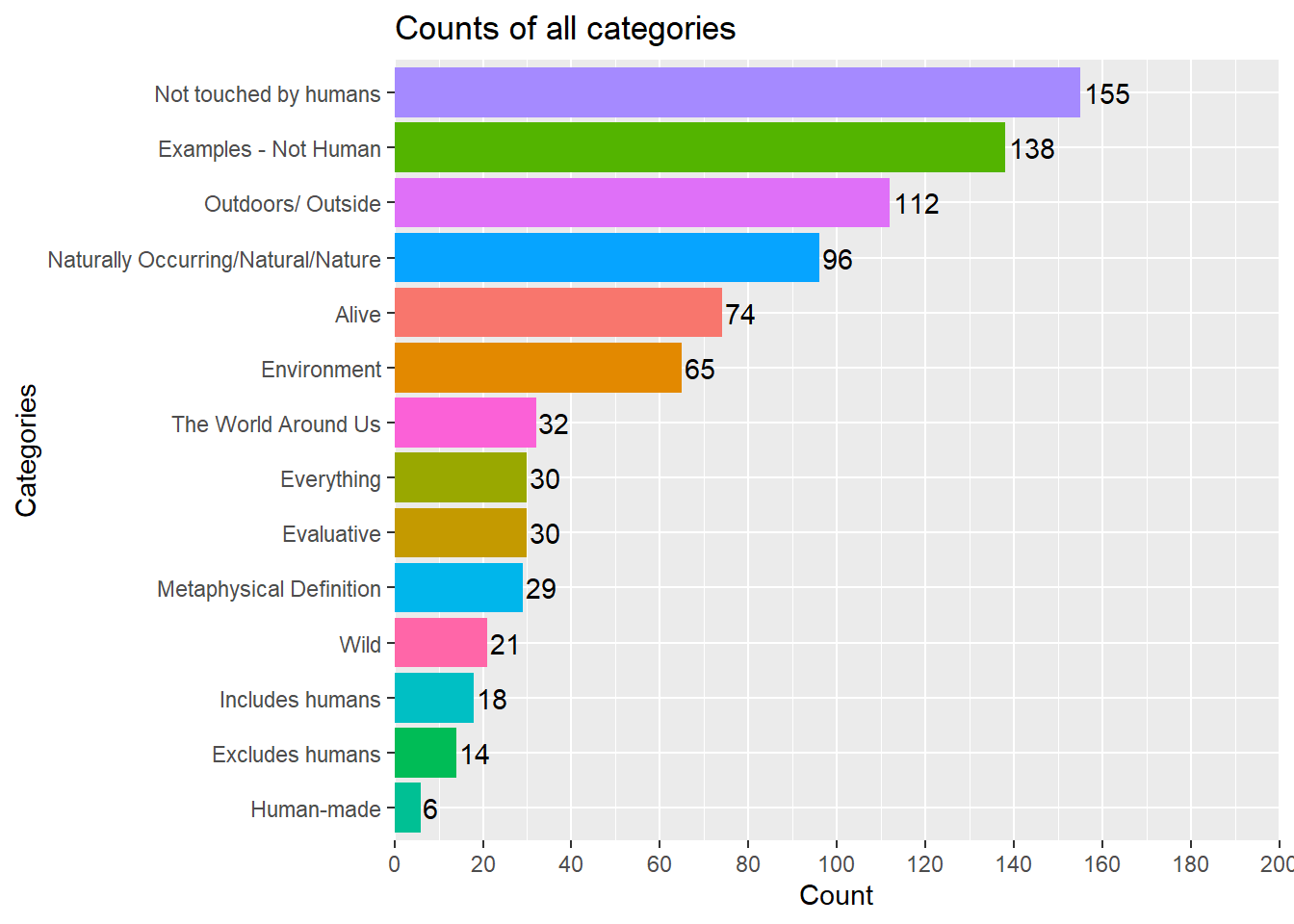
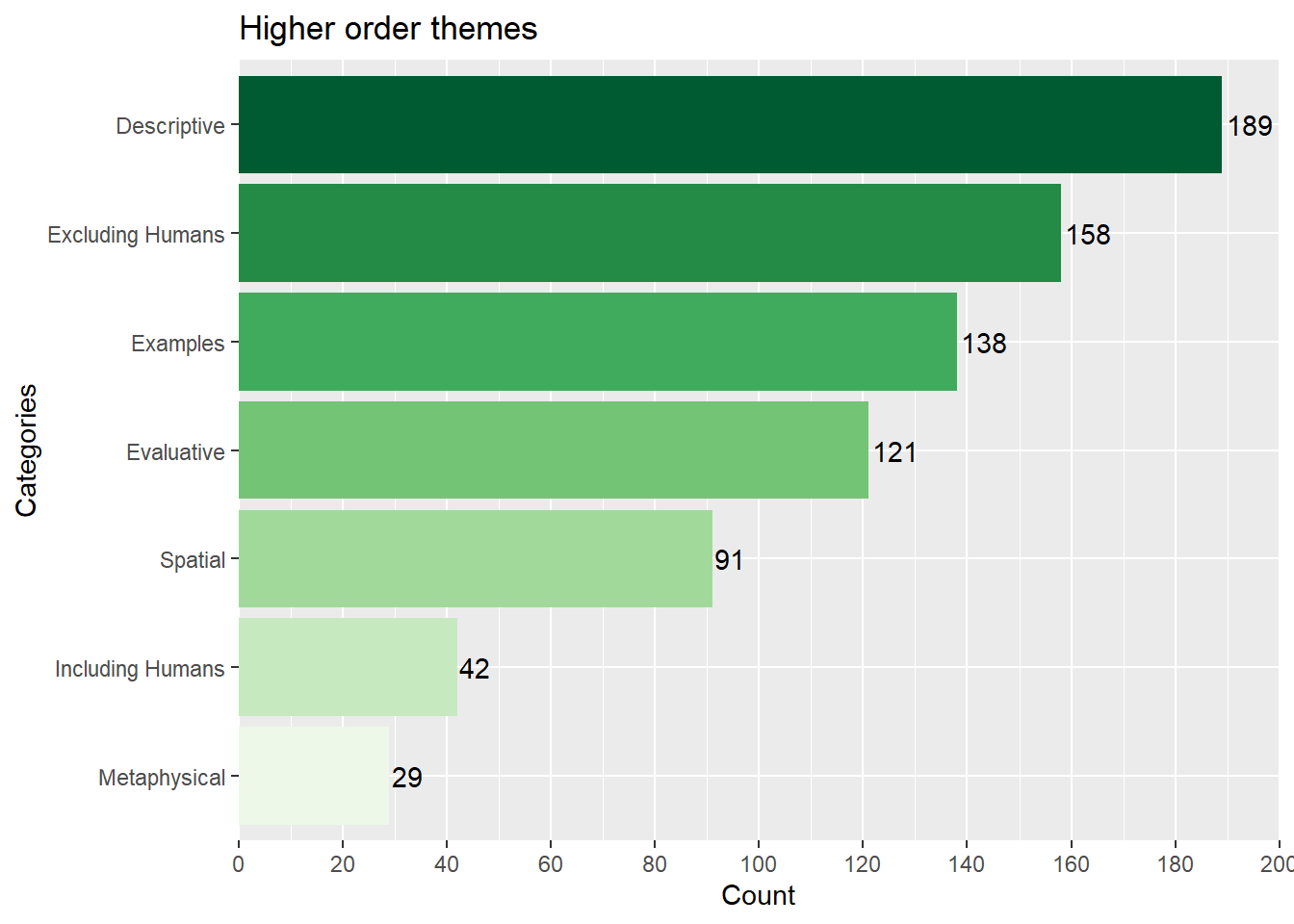
Examples of Codes
Descriptive Codes include 1. Alive 2. Wild (including wildlife) 3. Outdoors or Outside
Nature is all the living things on earth.
The outdoors, specifically the woods or the forest
Wilderness without anything manmade.
Exclusive Codes include: 1. Not touched by humans 2. Excludes humans
Everything not man-made.
Life outside of humans
Inclusive Codes include: 1. Everything 2. Includes humans 3. Human-made examples
Nature includes all humans, animals, plants, and even things like viruses and bacteria.
nature is our environment and everything in it (forest , birds , cities, humans )
the universe in which we exist and all things in it
Evaluative Codes include: 1. Moral value (e.g., being good, clean, naturally occurring) 2. Emotional value (e.g., pleasant, calm) 3. Aesthetic value (e.g., beautiful) 4. Applying a color (e.g., Green)
Nature is everything that is wholesome and original in the world
natural beauty, organic
nature is the outdoors, it’s the calm you feel when walking in the woods, its the sleep inducing feeling when it rains the joy you feel in the first snowfall.
Green and wild
Spatial Codes include: 1. The world around us 2. Environment
Nature is defined as the elements of life that surround us.
An outdoor environment that has not been completely changed by technology.
Examples Codes include: 1. lists of things that people associate with nature
All of the flora and fauna in the world, along with the geographic features of the world such as oceans, mountains, deserts, waterfalls, etc. Everything organic that is around us, even when we don’t pay attention to it.
Metaphysical Codes include: 1. Religious and/or spiritual connotations 2. Nature as something intrinsic
The raw existence of life.
Everything which God created.
Depends on context, but what immediately came to mind is Mother Nature, or just in general the great outdoors
Correlations between codes
People who use Spatial terms to define nature also tend to use more Evaluative terms. But they are less likely to use Metaphysical or Descriptive terms.
People who use Evaluative terms to define nature, tend to also use Metaphysical terms. But they are less likely to both Exclude Humans and Include Humans.
People who use Descriptive terms to define nature are more likely to give Examples. But they are less likely to Exclude Humans and use Metaphysical terms.
If you Include Humans in your definition, you are more likely to also use Metaphysical terms. Unsurprisingly, you are less likely to Exclude Humans in your defintion, but you are also less likely to use Evaluative terms.
If you Exclude Humans in your definition, you are less likely to give Examples or use Metaphysical, Descriptive, or Evaluative terms when defining nature.
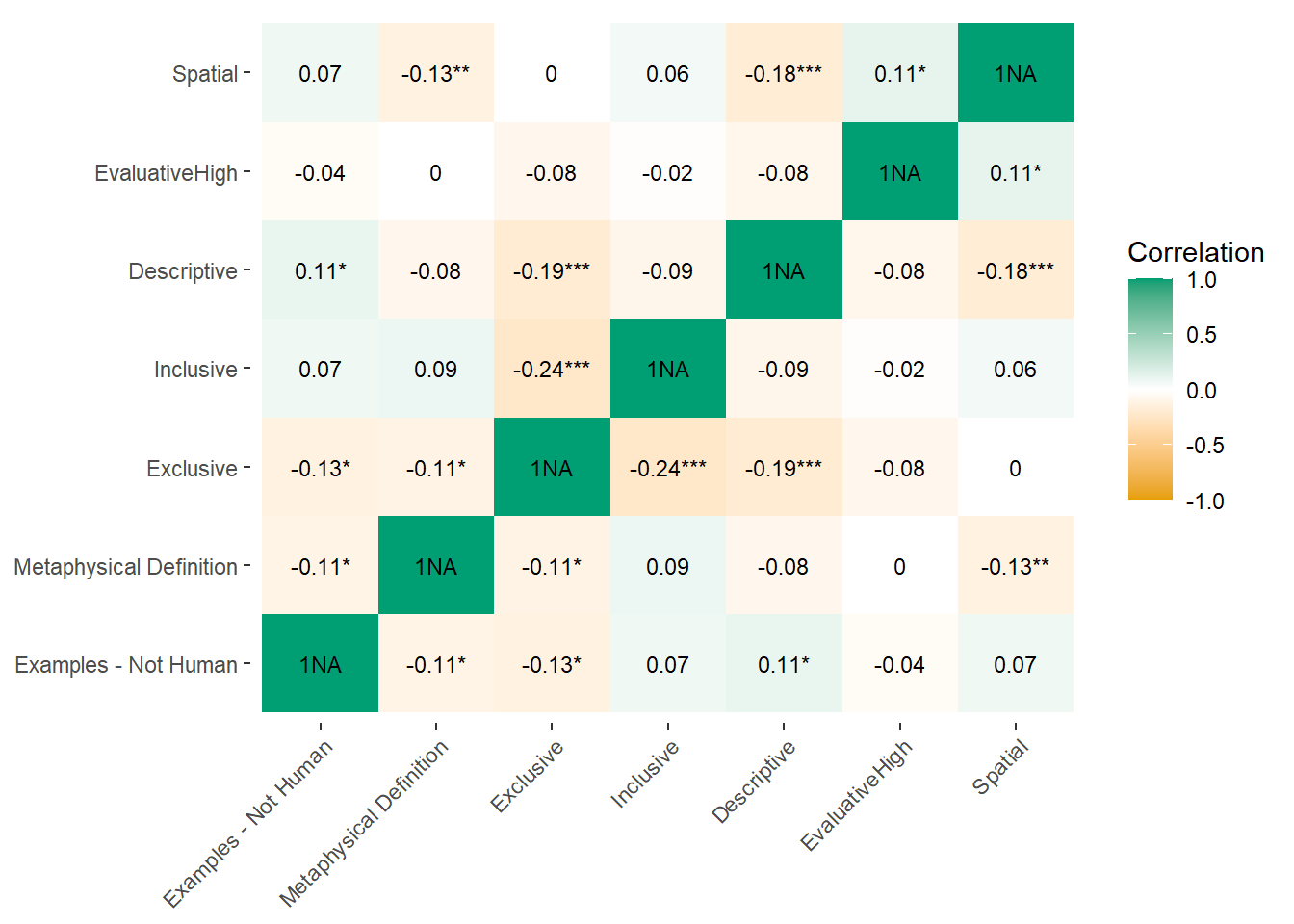
Relationship with Other Variables
Deep CTN and Presence within Nature are positively correlated with using Evaluative terms. (Also CTN overall positivley correlates with evaluative definitions)
Gender is correlated with both refering to nature as Outside (women more likely to say nature is outside) and Excluding Humans (women more likely to exclude humans).
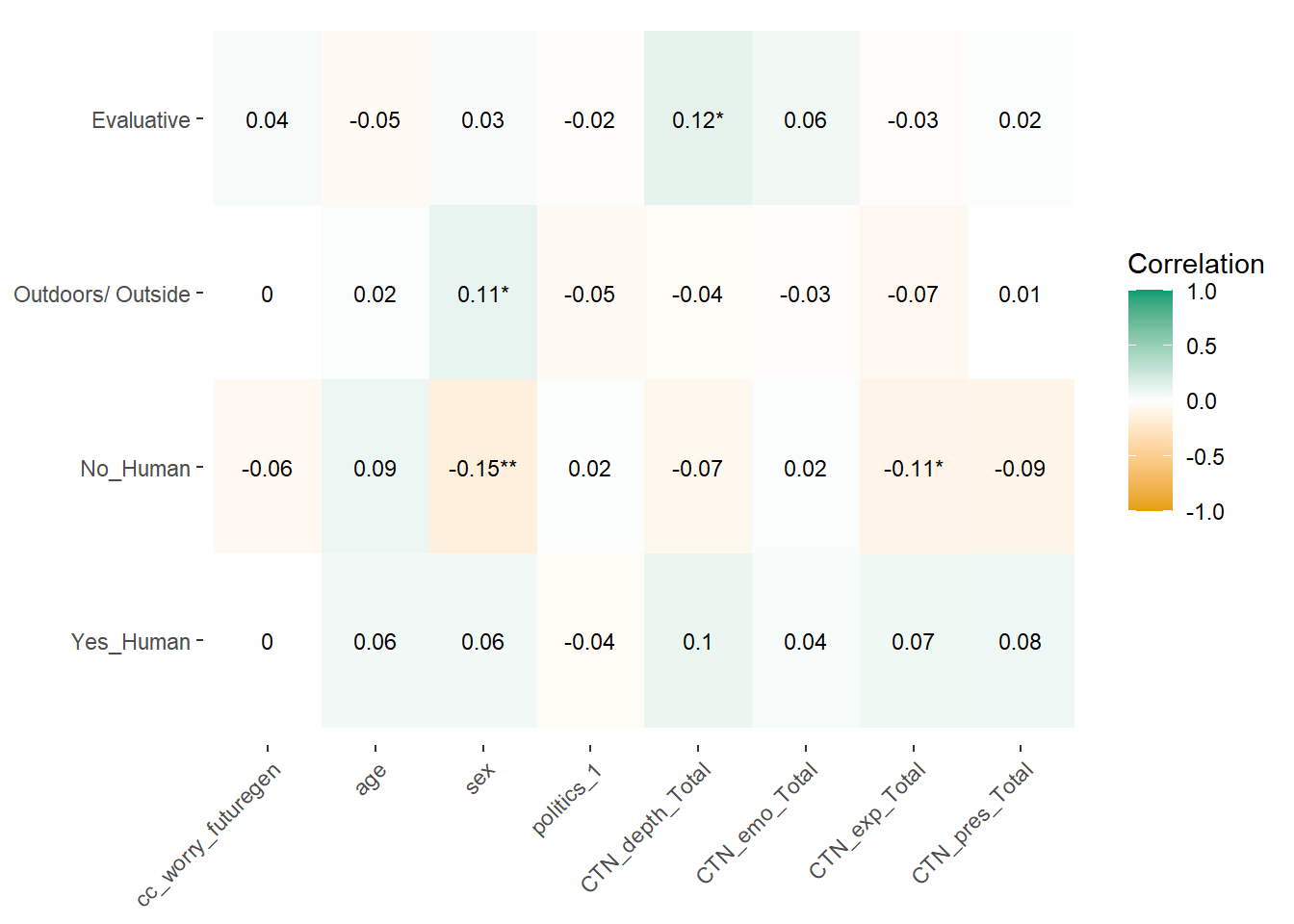
Logistic regression predicting the odds ratio for Including Humans in definition of nature | ||||
|---|---|---|---|---|
Variable | OR | 2.5 % | 97.5 % | p |
ctn_deep | 1.31 | 1.01 | 1.70 | 0.04 |
ctn_emo | 0.80 | 0.61 | 1.04 | 0.09 |
ctn_exp | 0.99 | 0.76 | 1.29 | 0.94 |
ctn_pres | 1.01 | 0.78 | 1.32 | 0.94 |
sexmale | 1.01 | 0.58 | 1.75 | 0.98 |
Logistic regression predicting the odds ratio for Excluding Humans in definition of nature | ||||
|---|---|---|---|---|
Variable | OR | 2.5 % | 97.5 % | p |
ctn_deep | 0.66 | 0.50 | 0.87 | 0.00 |
ctn_emo | 1.33 | 1.00 | 1.78 | 0.05 |
ctn_exp | 1.06 | 0.80 | 1.40 | 0.67 |
ctn_pres | 1.01 | 0.76 | 1.33 | 0.96 |
sexmale | 0.97 | 0.53 | 1.74 | 0.91 |
All of the above analysis was done using the manual coding that we did in the lab. Below I’m playing around with natural language processing in R using Quantdata.
Exploring Definitions with Quanteda
feature | frequency | rank |
|---|---|---|
world | 184 | 1 |
animals | 183 | 2 |
natural | 154 | 3 |
plants | 149 | 4 |
outside | 123 | 5 |
earth | 115 | 6 |
trees | 109 | 7 |
environment | 92 | 8 |
outdoors | 91 | 9 |
plants_animals | 87 | 10 |
things | 81 | 11 |
living | 64 | 12 |
around | 58 | 13 |
life | 44 | 14 |
around_us | 43 | 15 |
naturally | 39 | 16 |
everything | 39 | 16 |
water | 37 | 18 |
natural_world | 37 | 18 |
physical | 36 | 20 |
